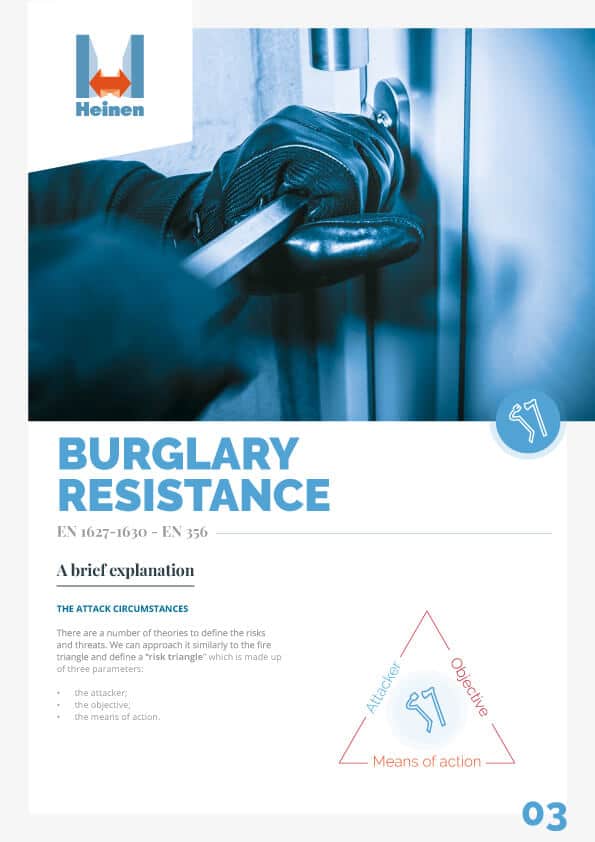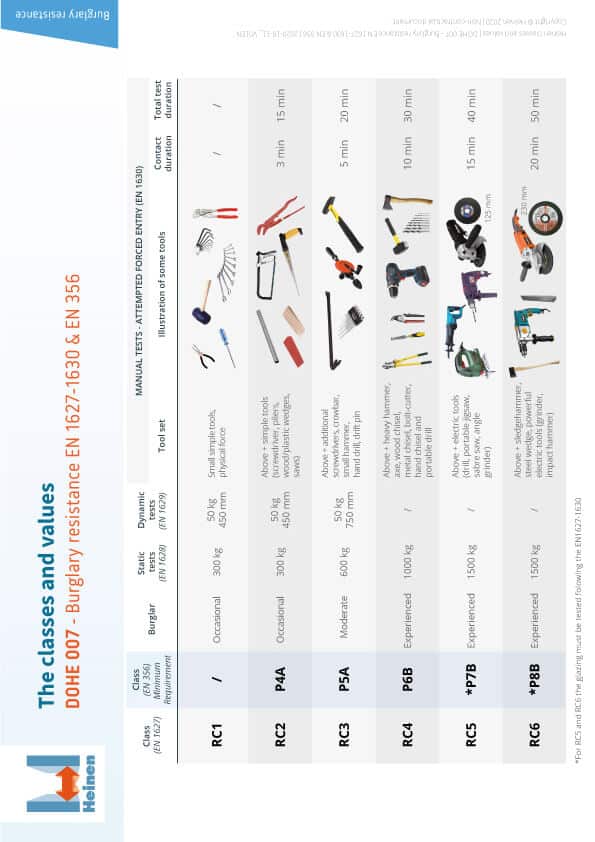Burglary resistance
EN 1627-1630
Justice
RC2, RC3, RC4, RC5
Talking about ‘burglary resistance’ is not entirely correct.
It would be more accurate to refer to ‘burglary retardant’. In fact, the means implemented (tools of attack) to force access to the protected zone are always seen in relation to the period of time available to the assailant and his level of experience.
In 80% of cases, the perpetrators first attack the door of the place to be burgled. So the door is the main element to be secured in the outer shell of the building.
Generally speaking, and whatever type of compartmentalisation is involved (burglary resistance, fire resistance, soundproofing, etc.) the openings into the building are the weak point.

The European standards for burglary resistance
EN 1627-1630
The sole reference at European level to assess the performance of burglar-retardant hardware is standard EN 1627 / 1628 / 1629 / 1630.
Heinen carries out all its burglary-resistance tests at the CNPP (National Centre for Prevention and Protection), one of the most renowned laboratories for anti-burglary tests.
The EN 1627-1630 standards offer a classification system made up of six categories (1 to 6 in ascending order of forced entry resistance) and describe the test methods used to evaluate the resistance of these components subjected to static and dynamic loading, as well as to manual forced entry attempts. Standard EN 1627 describes the test conditions and resistance classes.
The tests take place in three stages:
- Resistance to static loading (EN 1628)
- Resistance to dynamic loading (EN 1629)
- Resistance to manual burglary attempts (EN1630)
Standard 1627 describes the means used (force, tools, length of time, etc.) in manual burglary attempts to:
- succeed in opening the door
- or create an opening through which elements of specific dimensions can be passed (man hole)
During this test, a different tool set for each class is made available to the ‘attackers’. The attackers can use this and all the other tools listed in the lower classes. The contact time defined per class is the length of time during which the tools are in contact with the door. The total test time includes the contact time, rest time, observation time and ‘tool change’ time.
The attackers have the opportunity to study the plans of the door tested in advance to determine the potential vulnerabilities through which they could enter. This gives them a considerable advantage over an actual assault situation.
To see the table giving the tools and test times imposed for each « class in the standard ». download our documentation on the burglary-resistance standards !
Burglary resistance standards table
| Country | Europe | France |
|---|---|---|
| Standards | EN 1627 EN 1628 EN 1629 EN 1630 |
NF P20-551 NF P20-320 |
| Symbols | RC | / |
| Resistance class | RC1 to RC6 | Niv 5 A Niv 5 A, B Niv 5 A, B, B+ |
Resistance class |
RC2 RC3 RC4 RC5 |
Niv 5 A, B Niv 5 A, B, B+ |
Burglary resistant doors with cumulative performance
Whether you are looking for a door that meets the RC4 anti-burglary standard or the RC3 anti-burglary standard, Heinen is able to provide it, and even combine these performances with other features such as fire resistance, bulletproofing, or acoustic properties. Learn more about our anti-burglary doors and their specific features.


